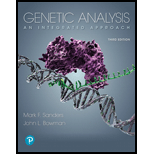
Concept explainers
Identify two general ways chemical mutagens can alter DNA. Give examples of these two mechanisms.
To review:
Analyze how chemical mutagens can alter DNA. Give examples of these two mechanisms of chemical mutation.
Introduction:
Mutation can be defined as a heritable change in the DNA sequence. This change in the DNA sequences either leads to evolutionary change in the DNA, or it changes the gene sequence which disturbs its desirable function and affects the fitness of the organism. Mutation occurs very rarely and randomly. The physical or chemical substance which causes the mutation in the DNA is called the mutagen. Examples of the physical mutagens are radioactive substances, X-rays, and ultraviolet rays, and those of chemical mutagens are Nitrous acid, Acridine, proflavin and Base analogues.
Explanation of Solution
Chemical mutagen is the compound which causes mutation in DNA as it alters the sequence of the DNA. Types of chemical mutation:
1) Base analogue mutation
2) Intercalating agents
3) Deamination
4) Alkylating agents
1) Base analogue mutation: A base analogue is the chemical compound that mimics nitrogen bases and gets incorporated in place of normal base in the DNA. As these compounds are not the true base pair, they possess some different characters of the pairing to the complementary base pair. This wrong incorporation of the nitrogen base in the DNA leads to mutation.
A known example of the base analogue is
2) Intercalating agents: A chemical that loads itself in between the stacked bases of the DNA is called the intercalating agent. This intercalation of chemicals in DNA results in either insertion or deletion of the bases; this results in frameshift mutation of the DNA.
The examples of intercalating agents are Acridine orange, proflavin, and acriflavin. These dyes have a three ringed structure which resembles with purine- pyrimidine base pairing. Purine has a double ring structure while the pyrimidine has a single ring structure; when they pair, they form a three ring structure. When the dyes intercalate into the DNA, it results in the deletion or insertion of the of the DNA replication, therefore frameshift mutation.
A chemical mutagen causes changes in the sequence of the DNA, it is called chemical mutation.
Want to see more full solutions like this?
Chapter 11 Solutions
Genetic Analysis: An Integrated Approach (3rd Edition)
- 1. Match each vocabulary term to its best descriptor A. affinity B. efficacy C. inert D. mimic E. how drugs move through body F. how drugs bind Kd Bmax Agonist Antagonist Pharmacokinetics Pharmacodynamicsarrow_forward50 mg dose of a drug is given orally to a patient. The bioavailability of the drug is 0.2. What is the volume of distribution of the drug if the plasma concentration is 1 mg/L? Be sure to provide units.arrow_forwardDetermine Kd and Bmax from the following Scatchard plot. Make sure to include units.arrow_forward
- Choose a catecholamine neurotransmitter and describe/draw the components of the synapse important for its signaling including synthesis, packaging into vesicles, receptors, transporters/degradative enzymes. Describe 2 drugs that can act on this system.arrow_forwardThe following figure is from Caterina et al. The capsaicin receptor: a heat activated ion channel in the pain pathway. Nature, 1997. Black boxes indicate capsaicin, white circles indicate resinferatoxin. a) Which has a higher potency? b) Which is has a higher efficacy? c) What is the approximate Kd of capsaicin in uM? (you can round to the nearest power of 10)arrow_forwardWhat is the rate-limiting-step for serotonin synthesis?arrow_forward
 Human Heredity: Principles and Issues (MindTap Co...BiologyISBN:9781305251052Author:Michael CummingsPublisher:Cengage Learning
Human Heredity: Principles and Issues (MindTap Co...BiologyISBN:9781305251052Author:Michael CummingsPublisher:Cengage Learning BiochemistryBiochemistryISBN:9781305577206Author:Reginald H. Garrett, Charles M. GrishamPublisher:Cengage LearningCase Studies In Health Information ManagementBiologyISBN:9781337676908Author:SCHNERINGPublisher:Cengage
BiochemistryBiochemistryISBN:9781305577206Author:Reginald H. Garrett, Charles M. GrishamPublisher:Cengage LearningCase Studies In Health Information ManagementBiologyISBN:9781337676908Author:SCHNERINGPublisher:Cengage Concepts of BiologyBiologyISBN:9781938168116Author:Samantha Fowler, Rebecca Roush, James WisePublisher:OpenStax College
Concepts of BiologyBiologyISBN:9781938168116Author:Samantha Fowler, Rebecca Roush, James WisePublisher:OpenStax College Biology (MindTap Course List)BiologyISBN:9781337392938Author:Eldra Solomon, Charles Martin, Diana W. Martin, Linda R. BergPublisher:Cengage Learning
Biology (MindTap Course List)BiologyISBN:9781337392938Author:Eldra Solomon, Charles Martin, Diana W. Martin, Linda R. BergPublisher:Cengage Learning Biology 2eBiologyISBN:9781947172517Author:Matthew Douglas, Jung Choi, Mary Ann ClarkPublisher:OpenStax
Biology 2eBiologyISBN:9781947172517Author:Matthew Douglas, Jung Choi, Mary Ann ClarkPublisher:OpenStax





